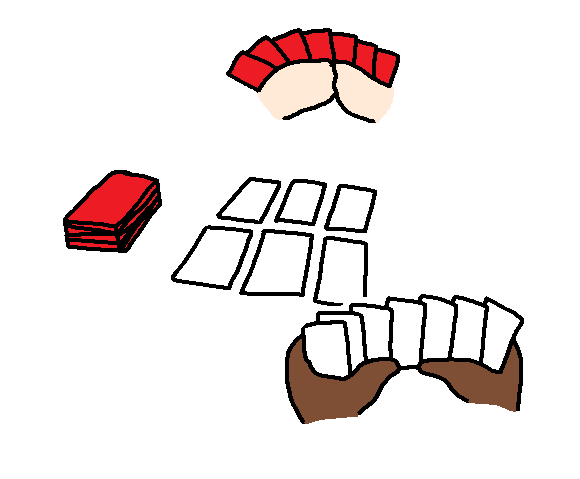Hachi [八, はち hachi, lit. “Eight”] is a hanafuda game for two players loosely based on Hana Awase, but with several unique characteristics, most notably its capture mechanic. In it, cards do not generally capture within their own suit as in other games of the genre, but rather may capture from a specific set of suits. Based on the similarity between their yaku inventories, it is likely related to the game Kekoro.
Due to the nature of the Yaku in this game, it is assumed that the game was originally played using Mekurifuda before it was adopted into a Hanafuda game. (Click here to see a possible way of playing this game using Mekurifuda)
¶ Setup
Game setup involves choosing a dealer [親 - おや, oya], shuffling the deck, and distributing the initial cards. Players may also wish at this time to set the duration of the game, whether it be to a number of rounds, points, or victories. A common option is for the first player to win two consecutive rounds by a margin of 20 points or more to win the overall game.
¶ Choosing the Dealer
Choose the initial dealer as seen fit; a typical method in hanafuda games is to shuffle the deck and have both players draw one card each. The player who drew a suit for the earliest month becomes the dealer. If both players drew from the same suit, the player drawing the higher point card becomes the dealer. In cases where there is a tie, this process can be repeated.
In subsequent games, the winner of the previous round becomes the new dealer.
¶ Distributing the Cards
At the beginning of each round, the dealer shuffles the deck and distributes 6 cards face-up to the field and 7 cards face-down to each player. These face-down cards become the players’ hands; the remaining cards in the deck become the draw pile for the round and should be set face-down next to the field.
Note that unlike in related games, nothing special happens if 3 or 4 cards of the same suit are dealt to the field. Likewise, there are no “lucky hands” in Hachi.
¶ Gameplay
Each round, the dealer is the first to play.
On your turn, choose one card from your hand to play to the field. If it matches another card on the field according to the Capture Chart below, overlap the two cards indicating that you will capture them. If your card has multiple potential matches, you must select only one of them to pair it with. If your played card does not have any matches on the field, it will simply become a field card.
After playing a card from your hand and making a match as is appropriate, flip over the top card from the deck and play it to the field in the same manner as above, again making a match according to the Capture Chart if possible. Once you have played a card both from your hand and the deck, collect any cards captured into your scoring area. Captured cards are public knowledge, and should be arranged in such a way that both players can see them. It then becomes the next player’s turn.
¶ Capture Chart
Two cards are considered a match in Hachi if the numeric value of their suits add up to a number whose last digit is 3 or 8, according to the standard ordering of suits. In practice, this means that cards marked as Group A in the table below capture cards in Group B, and vice versa; cards in Group C capture those in Group E, and vice versa. Group D cards capture other Group D cards.
| Group | Given Suit | Possible Captures |
|---|---|---|
| A | ||
| B | ||
| C | ||
| D | ||
| E |
¶ End of Round
The round ends when both players have exhausted their hands. At this point in time, each player calculates their score taking the sum of their cards’ individual values and adding it to the total points for any yaku they have completed, according to the tables in the following sections. The winner of the round is the player with the greater number of points.
¶ Card Values
| Point Value | Type of Card | Number in Deck |
|---|---|---|
| 1 | Ribbons | 10 |
| 10 | All Other Cards | 38 |
¶ Yaku
There are 21 yaku in the game of Hachi, which exist as 10 pairs of Ribbon and non-Ribbon variants, and one lone Ribbon yaku with no partner. Note that the ![]() Geese and
Geese and ![]() Colored Paulownia chaff stand in for Ribbons in the yaku in which they appear, despite their individual point values being higher than proper Ribbons.
Colored Paulownia chaff stand in for Ribbons in the yaku in which they appear, despite their individual point values being higher than proper Ribbons.
¶ Bibliography
- Johnson, Jason, and Antonietta Fazio-Johnson. “Hachi.” Hanafuda Games, Hanami ed., IndianWolf Studios, 2017. pp. 108-111.
- Shiragiku. “Hachi.” Marguerite, https://www.marguerite.jp/Nihongo/Games/しらぎく花札/はち.html .
